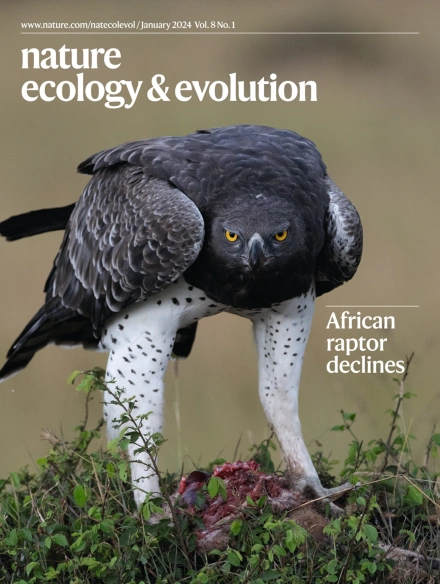Reduced water loss rather than increased photosynthesis controls CO2-enhanced water-use efficiency
IF 13.9
1区 生物学
Q1 ECOLOGY
引用次数: 0
Abstract
Numerous leaf-level experiments suggest that plant intrinsic water-use efficiency (iWUE) increases under elevated CO2 because of reduced stomatal conductance and enhanced photosynthesis. However, it remains elusive whether this response can be extrapolated to the ecosystem scale, because confounding factors and compensating feedbacks are often involved in ecosystem iWUE variations. Here we develop a machine learning-based framework to disentangle the ecosystem-scale CO2 effects on iWUE and its two components, canopy conductance (Gc) and gross primary productivity (GPP), based on global networks of long-term eddy covariance observations. Our results show widespread CO2-induced enhancement of iWUE across diverse ecosystems, driven predominantly by Gc reduction rather than GPP stimulation. Moreover, three divergent response types are identified across the studied ecosystems, based on the strength and significance of CO2-driven Gc reduction and GPP enhancement, indicating spatially non-uniform responses to rising CO2. Nutrient supply, water availability and biome types are found to be critical factors regulating this spatial heterogeneity. Overall, our study provides observational insights into ecosystem-scale CO2 fertilization effects. Such understandings are essential to inform terrestrial biosphere models for better projections of carbon and water cycles given the intensified changing climate in a CO2-rich future. A machine learning approach using long-term observations of eddy covariance finds that the increase in plant intrinsic water-use efficiency under higher CO2 levels, across diverse ecosystems, is driven primarily by reduction in canopy conductance, rather than by stimulation of gross primary productivity.


减少水分流失而不是增加光合作用控制二氧化碳提高的水利用效率
大量叶片水平的实验表明,由于气孔导度的降低和光合作用的增强,植物的内在水分利用效率(iWUE)在CO2升高的条件下增加。然而,这种响应是否可以外推到生态系统尺度,仍然是难以捉摸的,因为混淆因子和补偿反馈往往涉及生态系统的iWUE变化。在这里,我们开发了一个基于机器学习的框架,以解决生态系统尺度的CO2对iWUE及其两个组成部分,冠层电导(Gc)和总初级生产力(GPP)的影响,基于全球长期涡旋相关方差观测网络。我们的研究结果表明,在不同的生态系统中,二氧化碳引起的iWUE的广泛增强主要是由Gc减少而不是GPP刺激驱动的。此外,基于CO2驱动的Gc减少和GPP增强的强度和显著性,在研究的生态系统中发现了三种不同的响应类型,表明对CO2上升的响应在空间上不均匀。养分供应、水分有效性和生物群落类型是调节这种空间异质性的关键因素。总的来说,我们的研究提供了对生态系统尺度二氧化碳施肥效应的观察见解。鉴于未来气候变化加剧,二氧化碳含量高,这种理解对于陆地生物圈模型更好地预测碳和水循环至关重要。
本文章由计算机程序翻译,如有差异,请以英文原文为准。
求助全文
约1分钟内获得全文
求助全文
来源期刊

Nature ecology & evolution
Agricultural and Biological Sciences-Ecology, Evolution, Behavior and Systematics
CiteScore
22.20
自引率
2.40%
发文量
282
期刊介绍:
Nature Ecology & Evolution is interested in the full spectrum of ecological and evolutionary biology, encompassing approaches at the molecular, organismal, population, community and ecosystem levels, as well as relevant parts of the social sciences. Nature Ecology & Evolution provides a place where all researchers and policymakers interested in all aspects of life's diversity can come together to learn about the most accomplished and significant advances in the field and to discuss topical issues. An online-only monthly journal, our broad scope ensures that the research published reaches the widest possible audience of scientists.
 求助内容:
求助内容: 应助结果提醒方式:
应助结果提醒方式:


